
Page snapshot: Introduction to the fossils of the Blue Ridge and Piedmont region of the southeastern United States.
Topics covered on this page: Proterozoic (Precambrian) fossils, Paleozoic fossils, Mesozoic fossils; Resources.
Credits: Most of the text of this page is derived from "Fossils of the Southeastern US" by Warren D. Allmon, chapter 3 in The Teacher-Friendly Guide to the Earth Science of the Southeastern US, 2nd ed., edited by Andrielle N. Swaby, Mark D. Lucas, and Robert M. Ross (published in 2016 by the Paleontological Research Institution; currently out of print). The book was adapted for the web by Elizabeth J. Hermsen and Jonathan R. Hendricks in 2021–2022. Changes include formatting and revisions to the text and images. Credits for individual images are given in figure captions.
Updates: Page last updated March 12, 2022.
Image above: The footprint (Grallator) of a small theropod dinosaur from the Triassic Cow Branch Formation, Solite Quarry, Virginia-North Carolina border. Photo by James St. John (flickr, Creative Commons Attribution 2.0 Generic license, image cropped).
Proterozoic (Precambrian) fossils
The rocks of the Blue Ridge and Piedmont are largely metamorphic and igneous, although many of them were initially sedimentary and may have contained fossils. Remarkably, a few fossils managed to escape the destructive heat and pressure of metamorphism. These fossils are called Ediacarans.
The Ediacaran biota is an assemblage of fossils that was first described from southern Australia and dates to just before the beginning of the Cambrian (541–485 million years ago). It has since been found worldwide. Although the evolutionary affinities of the Ediacaran organisms have been controversial, it is widely accepted that they include some of the earliest-known fossil animals.
Ediacaran fossils come in a range of forms, including enigmatic fronds, disks, and other shapes. Some resemble modern animal groups. They range in size from centimeter-long to meter-long. All appear to have been soft-bodied, meaning that they lacked mineralized skeletons. None have been found with appendages or sensory structures, and most show no sign of feeding, digestive, or locomotory structures.
Scientists do not know whether the Ediacarans are all related to each other, or whether they represent several branches of the evolutionary tree. Nevertheless, the Ediacaran biota is an extremely important piece of the story of how and when complex animal life evolved during the late Precambrian.
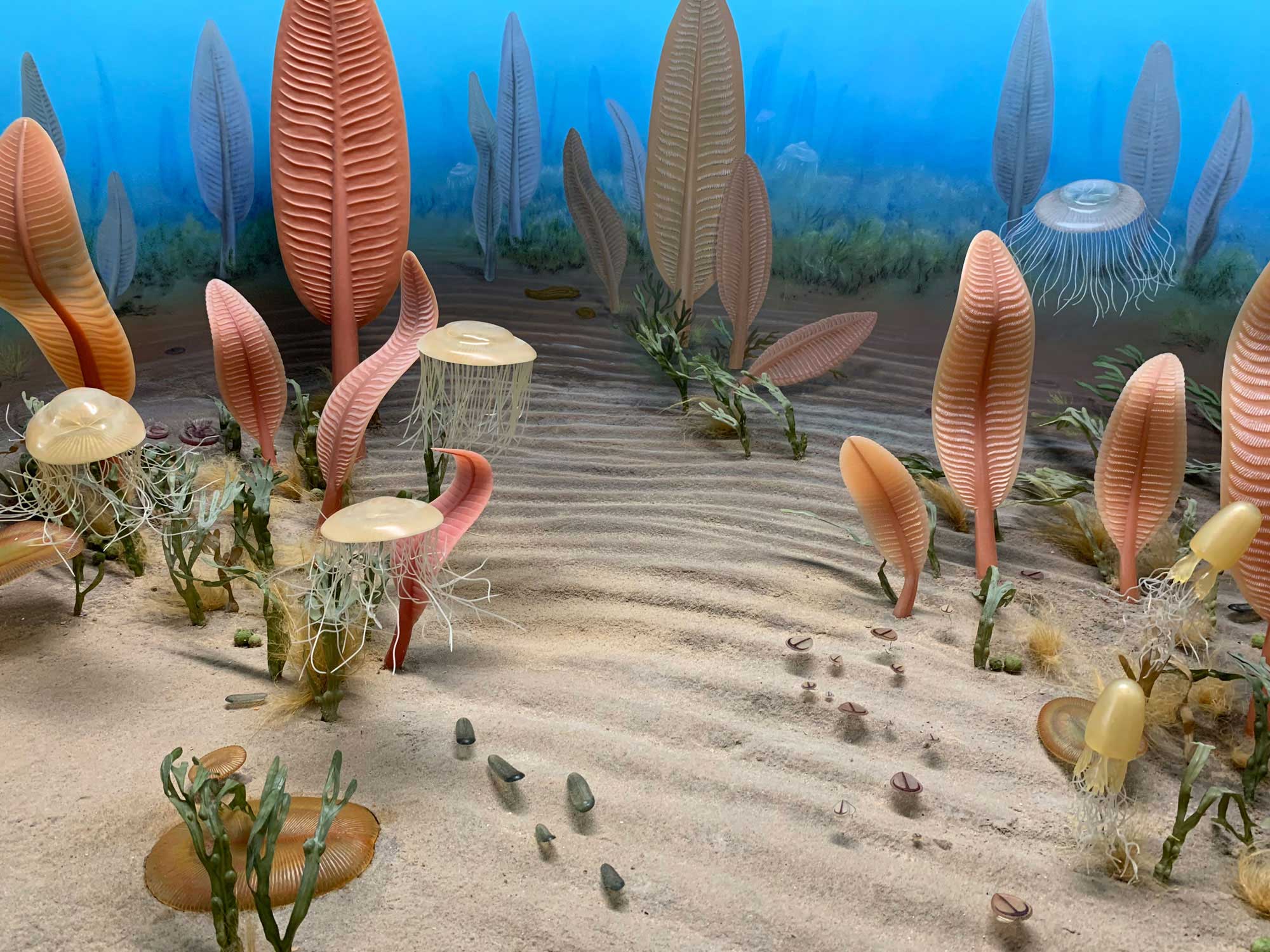
A diorama depicting life in the Ediacaran sea. Photograph by Jonathan R. Hendricks. Explore an interactive version of this diorama on Sketchfab.
The oldest known fossils in the Southeast come from Stanly County in North Carolina. In the early 1970s, a man found what looked like a trilobite (learn more) in one of the rocks he was using to build a chimney. It turned out to be not a trilobite, but a fossil from the Ediacara biota. A small number of additional Ediacaran-type fossils have been found in similar rocks in Stanly County. All of these rocks appear to date to between 542 and 556 million years ago. This dates them to just before the Cambrian Explosion, making these fossils among the youngest representatives of the Ediacaran biota in the world.
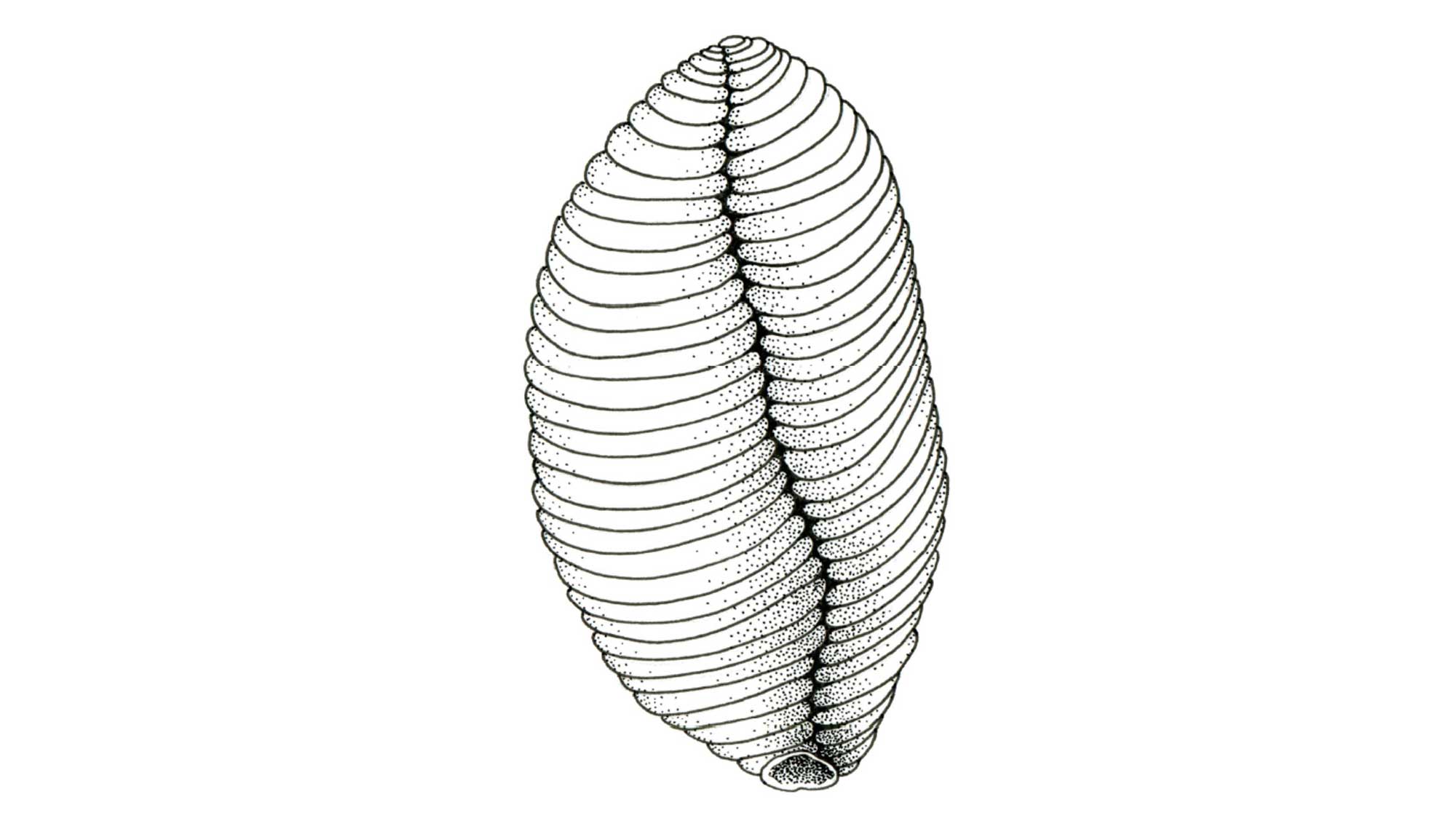
Fossil "frond" assigned to the Ediacaran organism Pteridinium, late Precambrian, Stanly County, North Carolina. Approximately 9 centimeters (3.5 inches) long. Drawing by Christi Sobel based on fig. 5 in Gibson et al. (1984) Geology, 12: 387–390.
Paleozoic fossils
Cambrian rocks are not widespread in the Southeast, but some Cambrian sediments exposed in the southern Appalachians do contain well-preserved fossils. For example, archaeocyathans (learn more) are found in metamorphosed early Cambrian carbonate rocks (marbles) in the Talladega Slate Belt of northeastern Alabama and northwestern Georgia. Several species of middle Cambrian trilobites occur in rocks that are part of the Carolina Slate Belt. For example, trilobites from the Asbill Pond Formation near Batesburg (Lexington County), South Carolina, are similar to trilobites from ancient paleocontinents that geologists call Armorica and Baltica (modern western and central Europe), but bear little similarity to the fossils of Laurentia (modern North America and western Europe).
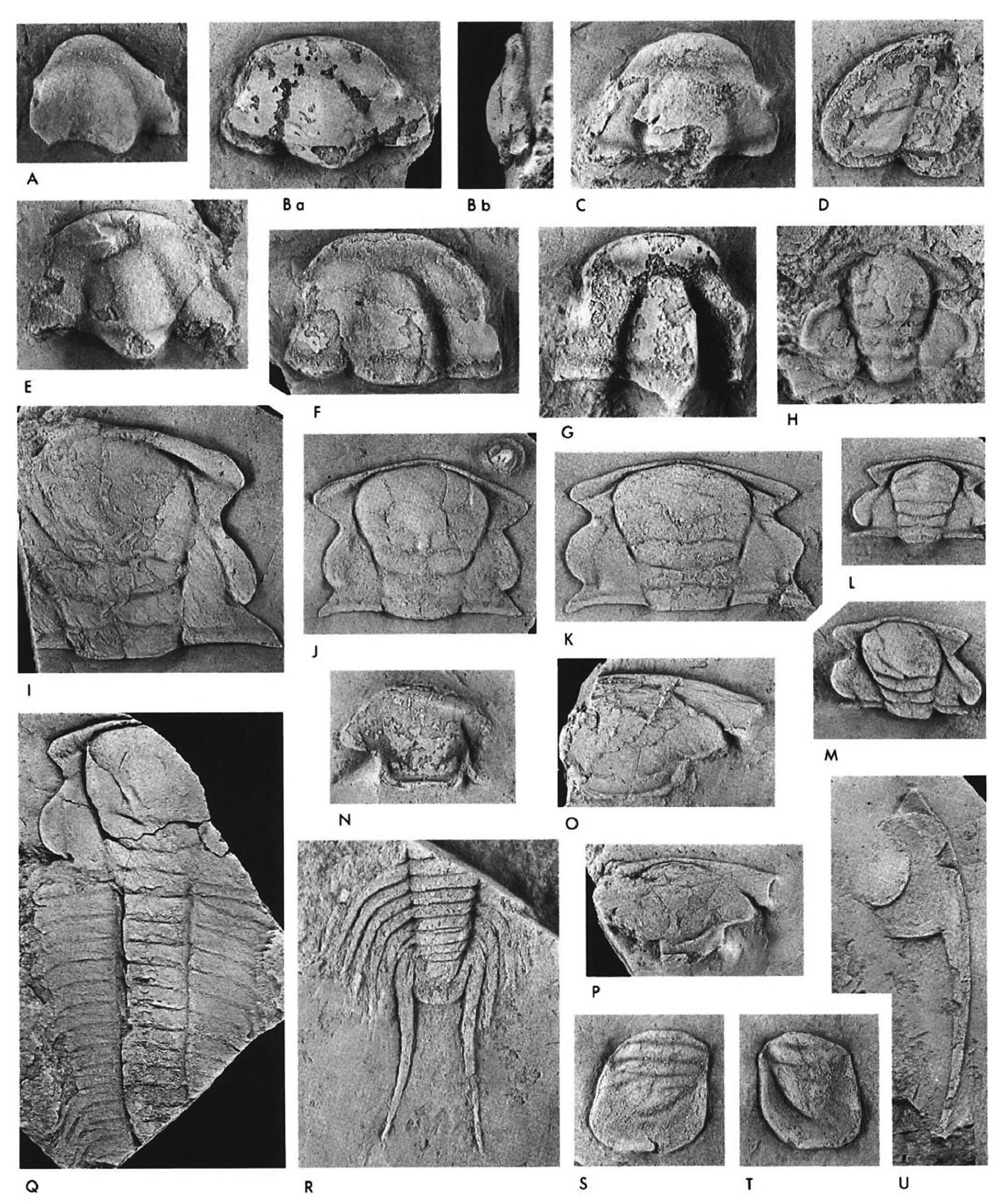
Examples of Cambrian trilobites from the Asbill Pond formation, South Carolina. A–F. Agraulos sp. G. Skreiaspis? sp. H. Paradoxides sp. I–U. Paradoxides cf. polonicus. Image is from Samson et al. (1990) Geology 102: 1459–1470 (shared here in accordance with the Geological Society of America's fair use policy concerning sharing of individual images from GSA papers (image copyright Geological Society of America).
This peculiar fossil distribution is compatible with the Carolina Slate Belt's history as an exotic terrane that was added to North America during the early to middle Paleozoic. Almost all younger Paleozoic rocks in the Piedmont are metamorphic, and fossils are uncommon in them. In some places, such as Buckingham County, Virginia, fossils were deformed by the tectonic forces of mountain building long after they had been buried.

A Cambrian trilobite (Wanneria walcottana), deformed by mountain building. This particular specimen is from the Kinzers Formation of Pennsylvania (PRI 76846). A 3D model of this specimen is available to view on Sketchfab. Specimen is from the collections of the Paleontological Research Institution, Ithaca, New York.
Mesozoic fossils
Triassic and Jurassic
The Triassic to Jurassic rift basin rocks of the Piedmont formed after the Paleozoic orogenies had ended and the Atlantic Ocean began to widen. Lakes were common in these basins. Sediments deposited in and around the lakes—part of what geologists call the Newark Supergroup—contain fossils that record freshwater environments and terrestrial habitats along lake margins. The most common fossils are fishes, plant remains, and the footprints (trace fossils) of reptiles and amphibians.
Plant remains can be particularly abundant in these rift valley sediments and include a variety of foliage (leaf) types, such as ferns, cycadeoids, ginkgoes, and conifers.

Cycadeoid frond (probably Zamites) from the Upper Triassic Pekin Formation of North Carolina. Cycadeoids are an extinct group of seed plants that somewhat resemble (but are not related to) palms. The frond consists of a rachis (a central axis) with pinnae (leaflets) that come off either side. Photo by James St. John (flickr, Creative Commons Attribution 2.0 Generic license, image cropped and resized).
Trace fossils are marks left by the behavior of organisms on sediment or other substrate. Traces include burrows, footprints, toothmarks, holes drilled in shells by predators, and the tunnels left by plant roots. Because paleontologists can almost never be sure of exactly which kind of organism made a particular trace, there is a completely separate system of naming trace fossils that does not refer to organisms represented by body fossils. Despite this difficulty, trace fossils are widely used to help reconstruct ancient environments.
The Triassic-Jurassic rift basins of the East Coast have been renowned for their dinosaur trackways since the early nineteenth century, and the basins of North Carolina and Virginia do not disappoint in this respect (see examples here of Triassic dinosaur footprints at the Luck Stone quarry in Culpepper, Virginia). The tracks and skeletal fossils of crocodilians and the small reptile Tanytrachelos are also well documented from other sites, including the famous Solite Quarry near the Virginia-North Carolina state line (see images of fossils from the Solite Quarry on Flickr).
The aetosaurs Coahomasuchus chathamensis and Gorgetosuchus pekinensis are known from the Pekin Formation in North Carolina. (Aetosaurs are a group of armored reptiles that are distantly related to modern crocodiles.) The predatory archosaur Postosuchus alisonae has also been found in the Deep River Basin.
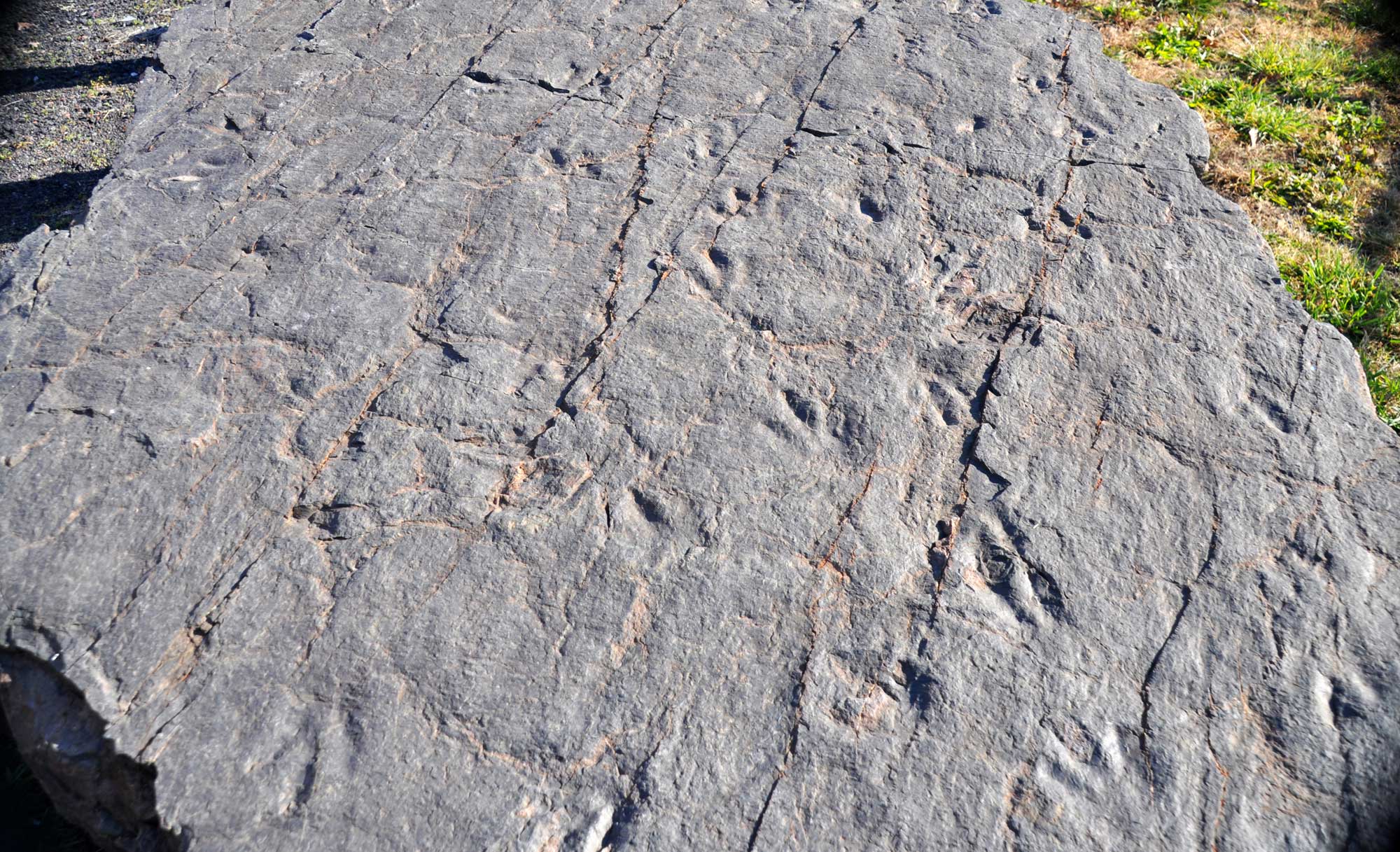
Dinosaur trackway. This slab comes from the Cow Branch Formation and was collected from the Solite Quarry on the North Carolina-Virginia border. The tracks are Late Triassic in age and are assigned to the footprint genus Grallator, thought to be the footprints of a small theropod dinosaur like Coelophysus. Photo by James St. John (flickr, Creative Commons Attribution 2.0 Generic license, image resized).
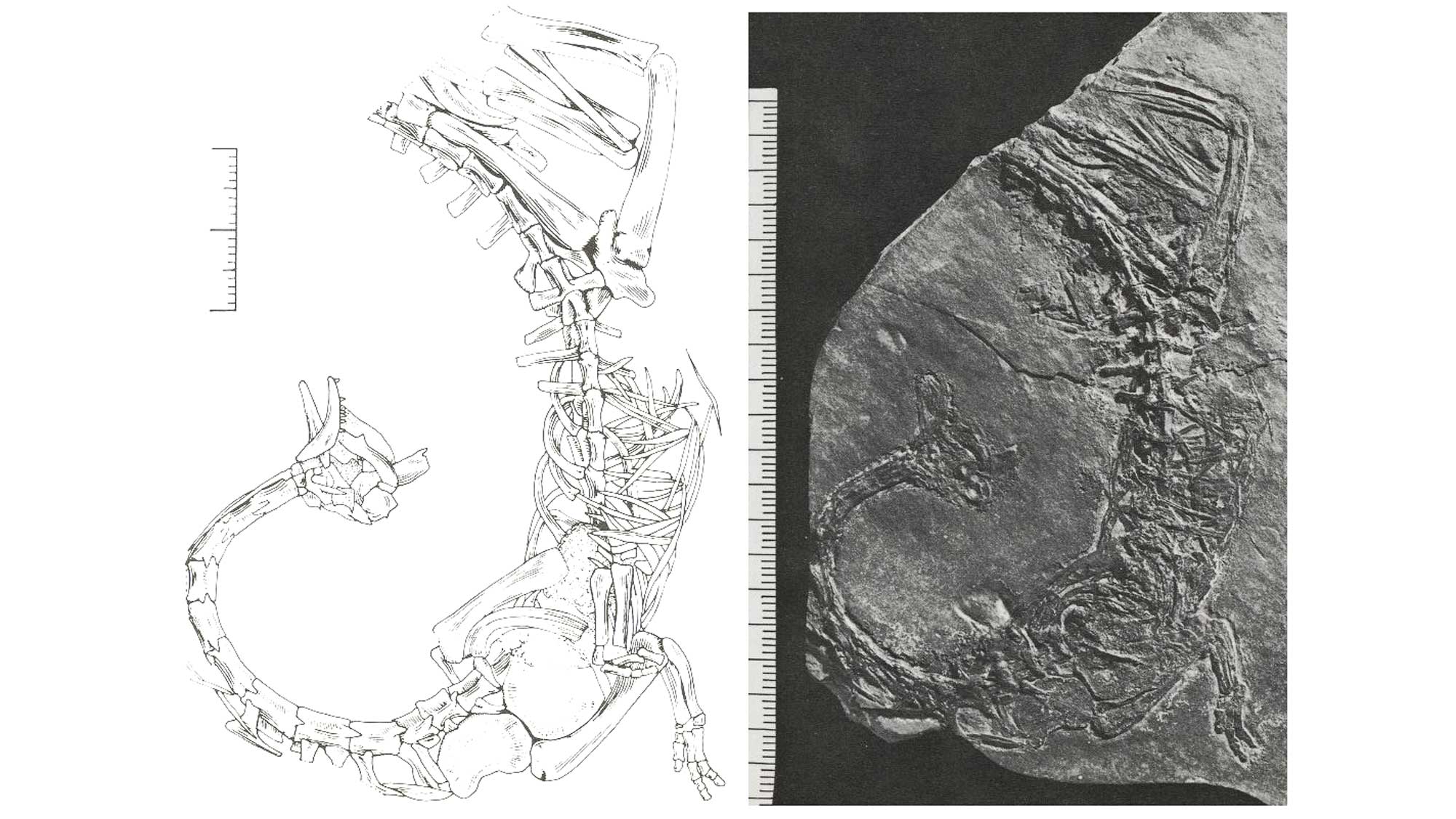
Drawing (left) and photograph (right) of the type specimen of Tanytrachelos ahynis (YPM 7496), a small, Late Triassic reptile that was approximately 13 cm (5 in) long. The animal is oriented with its tail toward the top of the figure. Image modified from fig. 2 in Olsson (1979) Postilla, 176: 1–14 (via Biodiversity Heritage Library; copyright Yale Peabody Museum of Natural History, reproduced here in accordance with a Creative Commons Attribution-NonCommercial-ShareAlike 3.0 Unported license).
The rift valley lakes contained fish, which are found as fossils in rocks that formed from lake bottom sediments. Many of these fossils are from an extinct group armored with thick, bony scales.

Triassic fish (Redfieldia gracilis) from the Late Triassic Newark Supergroup (Bull Run Shale), Fauquier County, Virginia. Photo of specimen USNM V18385 (Smithsonian National Museum of Natural History, pubic domain).
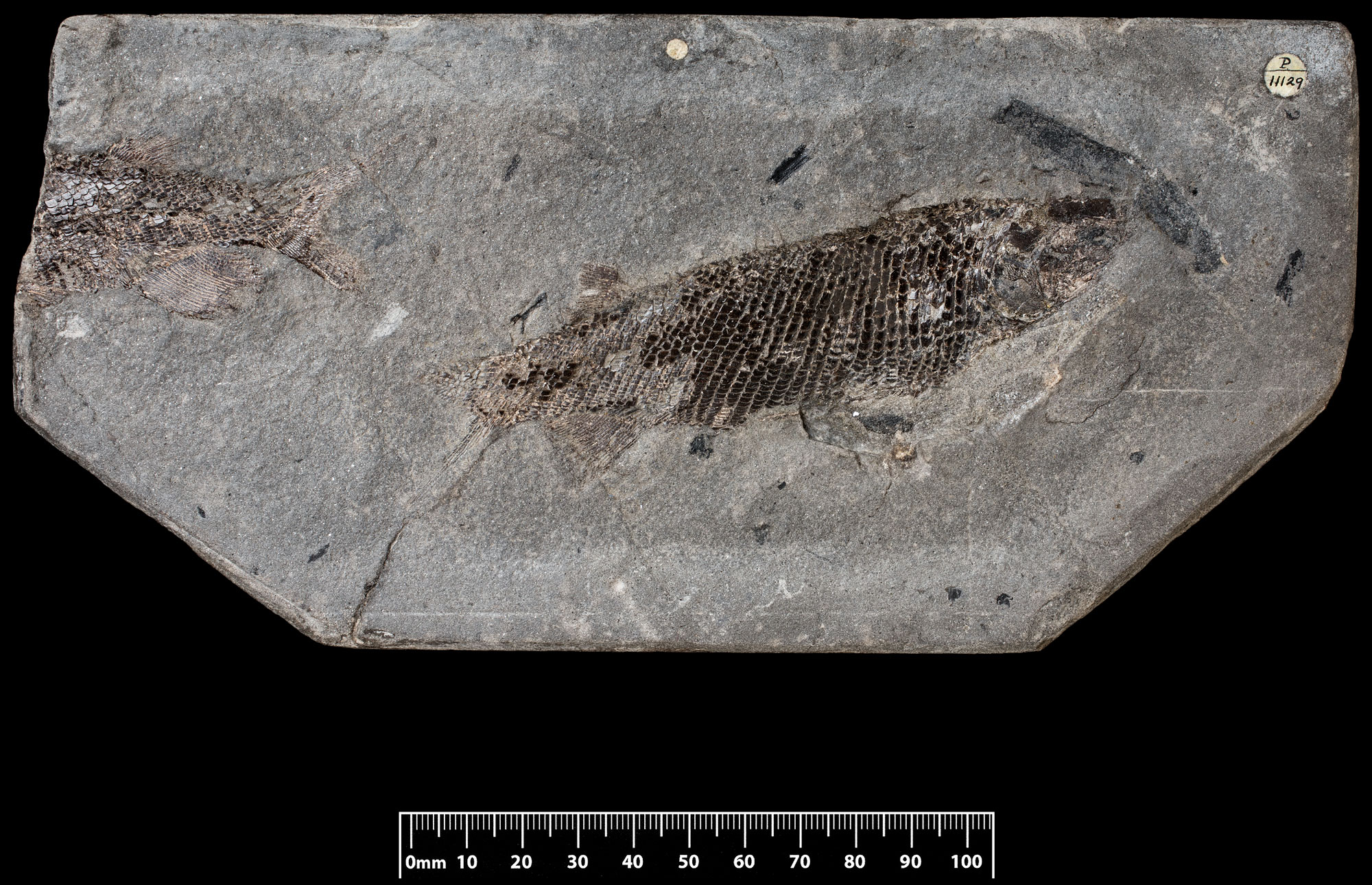
Triassic fish (Dictyopyge macrurus) from the Late Triassic of Virginia. Scale bar is in millimeters (10 mm = 0.4 in). Photo of specimen PV P 11129 from the British Museum (copyright British Museum, Creative Commons Attribution 4.0 International license, image resized and cropped).
Fossil invertebrates in the Newark Supergroup rocks include clams, crustaceans, and abundant insects. Many invertebrate fossils preserved remains of soft tissue and delicate features like wings and antennae. A few factors may account for the extraordinary preservation of these fragile organisms. Lake-bottom waters may have been poorly oxygenated, which would have slowed decomposition. Alternatively, saline and alkaline water chemistry may have discouraged predators and bioturbation (burrowing) that otherwise would have contributed to breakdown of body parts.

Exceptionally preserved insect fossils from the Triassic Solite Quarry in Virginia. Modified from figs. 5 and 6 in Blagoderov et al. (2007) American Museum Novitates no. 3572 (via Biodiversity Heritage Library, copyright American Museum of Natural History, licensed here under a Creative Commons Attribution-NonCommercial-ShareAlike 4.0 International license).
Cretaceous
A small band of Cretaceous rocks is exposed in northeastern Virginia. Petrified wood is found in Prince William Forest Park, located southwest of Washington, DC. This wood is thought to belong to bald cypress (Taxodium), a type of conifer that is still found in the coastal plain of the southeastern United States today.
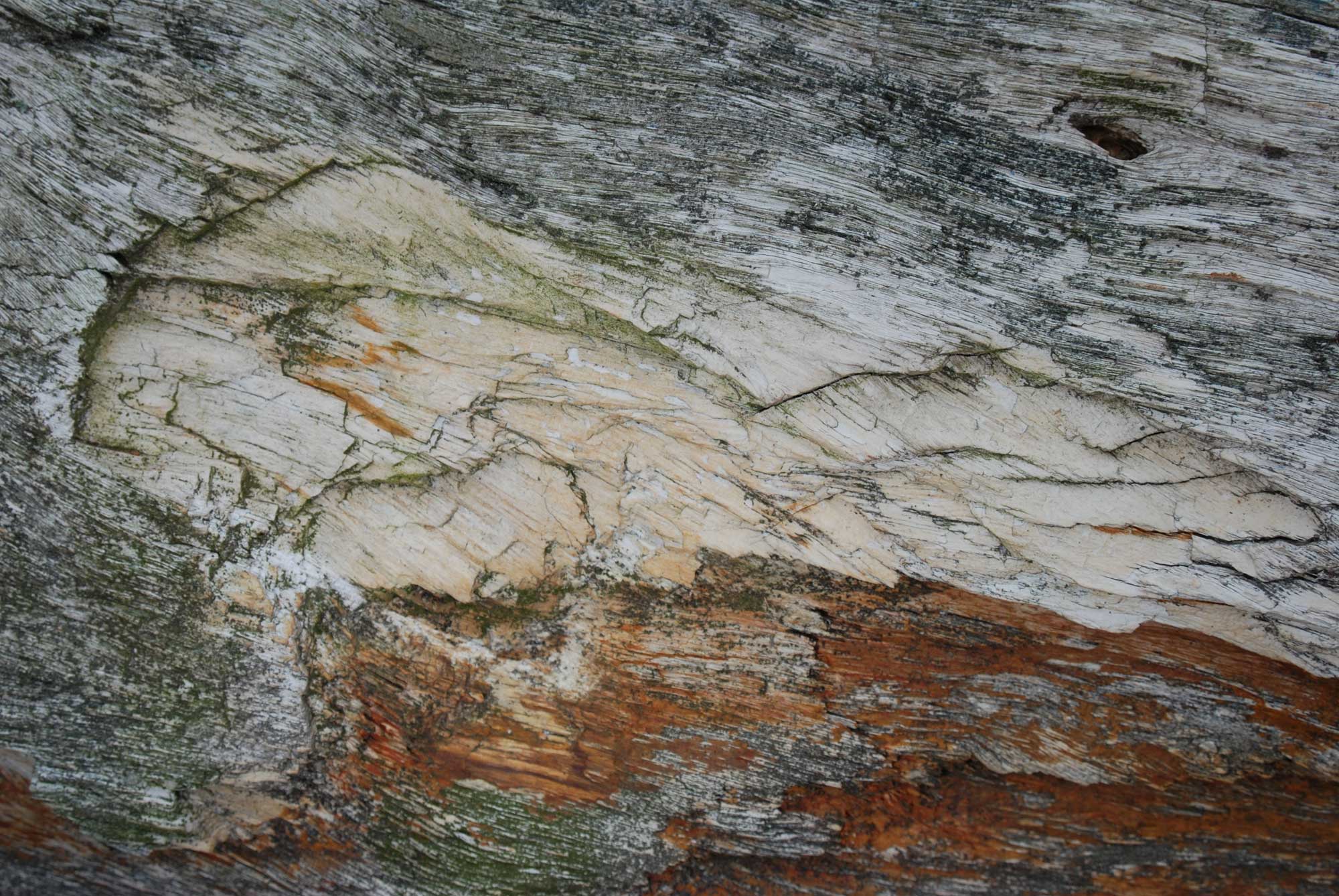
Close-up of fossilized bald cypress (Taxodium) wood, Prince William Forest Park, northeastern Virginia. Photo by Erich Junger (National Park Service, public domain).
Resources
Resources from the Paleontological Research Institution & partners
Digital Atlas of Ancient Life Virtual Collection: https://www.digitalatlasofancientlife.org/vc/ (Virtual fossil collection featuring 3D models of fossil specimens sorted by group)
Digital Encyclopedia of Ancient Life: https://www.digitalatlasofancientlife.org/learn/
Earth@Home: Quick guide to common fossils: https://earthathome.org/quick-faqs/quick-guide-common-fossils/



